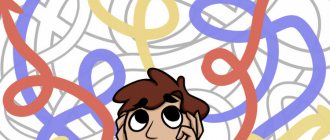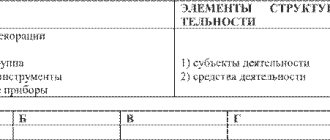Cognitive dissonance is a negative condition in which individuals experience mental discomfort caused by confrontation in their minds of conflicting ideas, values, knowledge, worldviews, ideas, beliefs, behavioral attitudes or reactions of an emotional nature.
The concept of cognitive dissonance was first proposed by L. Festinger, a specialist in the field of psychology of thought control. In his research during the analysis of the individual’s worldview, he was based on the principles of balance. He began his theory with the postulate that individuals strive for a certain coherence as a necessary internal state. When contradictions arise among individuals between their knowledge base and actions, they strive to somehow explain such a contradiction, as a result of which they present it as a “non-contradiction” in order to achieve a sense of internal cognitive coherence.
Causes of cognitive dissonance
The following factors are identified that cause a state of cognitive dissonance, as a result of which individuals often feel internal dissatisfaction:
- logical inconsistency;
- the dissimilarity of one person’s opinion with the generally accepted one;
- reluctance to follow cultural norms established in a certain territory, where traditions are sometimes guided more than by legislation;
- a conflict between an already experienced experience and a similar new situation.
Cognitive personality dissonance arises due to the inadequacy of the individual’s two cognitions. A person, having information on a problem, is forced to ignore it when making a decision and, as a result, a discrepancy or dissonance appears between the individual’s ideas and his actual actions. As a result of such behavior, a change in certain ideas of the individual is observed. Such a change is justified based on the vital need of a person to maintain the consistency of his own knowledge.
That is why humanity is ready to justify its own mistakes, because an individual who has committed an offense tends to look for excuses for himself in his thoughts, while gradually shifting his own attitudes regarding what happened in the direction that what happened in reality is not so terrible. In this way, the individual “manages” his own thinking in order to minimize confrontation within himself.
Festinger's modern theory of cognitive dissonance finds its goal in the study and interpretation of contradictions that arise both in individual human individuals and in groups of people.
Each individual, over a certain period of time, acquires a certain amount of life experience, but beyond the time limit, he must function according to the circumstances in which he exists, contrary to the acquired knowledge. This will cause psychological discomfort. And to alleviate such discomfort, the individual has to find a compromise.
Cognitive dissonance in psychology is an attempt to explain the motivation of human actions, their actions in a variety of everyday situations. And emotions are the main motive for appropriate behavior and actions.
In the concept of cognitive dissonance, logically contradictory knowledge is assigned the status of motivation, which is designed to ensure the elimination of the emerging feeling of discomfort when faced with inconsistencies through the transformation of existing knowledge or social prescriptions.
The author of the theory of cognitive dissonance, L. Festinger, argued that this state is the strongest motivation. According to the classical formulation of L. Festinger, cognitive dissonance is a discrepancy between thoughts, attitudes, information, etc., while the denial of one concept comes from the existence of another.
The concept of cognitive dissonance characterizes methods for eliminating or smoothing out such contradictions and demonstrates how an individual does this in typical cases.
Cognitive dissonance - examples from life: two individuals entered the institute, one of whom was a medalist, and the second was a C student. Naturally, the teaching staff expects excellent knowledge from a medal winner, but nothing is expected from a C student. Dissonance occurs when such a C student answers the question more competently, more comprehensively and completely than the medalist.
Objectivity of experiments conducted by the authors of the theory
There are also individual differences in whether people act as the theory predicts. Highly anxious people are more likely to do this. Many people seem to be able to cope with significant incongruity and do not behave predictably.
Finally, many studies supporting cognitive dissonance theory have low validity. For example, turning pegs (as in Festinger's experiment) is an artificial task that does not occur in everyday life. Additionally, most experiments used students as participants, which raise issues of sample bias. Can we generalize the results of such experiments?
Cognitive dissonance theory
Most motivational theories were first discovered in the works of ancient philosophers. Today there are already several dozen such theories. In modern psychological teachings about motivation, which claim to explain human behavior, the prevailing approach today is the cognitive approach to the motivational sphere of the individual, in which phenomena associated with the understanding and knowledge of the individual are of particular importance. The main postulate of the authors of cognitive concepts was the point of view that the behavioral reactions of subjects are guided by knowledge, judgments, attitudes, ideas, views about what is happening in the world, opinions about the causes and their consequences. Knowledge is not a simple collection of data. An individual’s ideas about the world predetermine and construct future behavior. Everything an individual does and how he does it depends not so much on fixed needs, deep aspirations and eternal desires, but on relatively changeable ideas about reality.
Cognitive dissonance in psychology is a state of discomfort in the individual’s psyche, provoked by the confrontation of conflicting ideas in his mind. The socio-psychological study of cognitions was developed to explain changes in cognitions (opinions, attitudes, attitudes) as a method of eliminating logical conflict situations.
Cognitive personality dissonance is characterized by a specific feature, which consists in linking together intelligence and affect, in other words, the emotional and cognitive components of attitudes.
The state of cognitive dissonance arises as a result of the individual’s awareness that his actions do not have sufficient grounds, that is, he acts in confrontation with his own attitudes and attitudes, when the personal meaning of behavior is unclear or unacceptable for individuals.
The concept of cognitive dissonance argues that, of the possible methods of interpreting and evaluating such a situation (objects) and one’s own actions in it, an individual gives preference to those that generate a minimum of anxiety and remorse.
Cognitive dissonance - examples from life were given by A. Leontiev: revolutionary prisoners who were forced to dig holes certainly perceived such actions as meaningless and unpleasant, a decrease in cognitive dissonance occurred after the prisoners reinterpreted their own actions - they began to think that they were digging the grave of tsarism. This idea contributed to the emergence of an acceptable personal meaning for the activity.
Cognitive dissonance can arise as a consequence of past actions. For example, when an individual in a specific situation has committed an act, which then provokes the appearance of remorse in him, as a result of which amendments can be made to the interpretation of circumstances and their assessment, which eliminate the grounds for experiencing this state. In most cases, this turns out to be simple, since life circumstances are often ambiguous. For example, when a smoker learns about the discovery of a cause-and-effect relationship between the occurrence of cancer and smoking, he has many tools aimed at reducing cognitive dissonance. Thus, in accordance with cognitive theories of motivation, an individual’s behavior depends on his worldview and cognitive assessment of the situation.
How to get rid of cognitive dissonance? Often, external attribution or justification is used to eliminate cognitive dissonance. Responsibility for actions can be removed by recognizing them as forced measures (forced, ordered) or justification can be based on self-interest (they paid well). In cases where there are few reasons for external justification, another method is used - changing attitudes. For example, if an individual was forced to lie, then unconsciously he amends his original judgment about reality, adjusting it to a “false statement”, as a result of which it is subjectively transformed into the “truth”.
The author of the theory of cognitive dissonance, Leon Festinger, admits that individuals can even believe what they previously reported insincerely, and thus achieve consonance.
According to a number of postulates, this concept converges with the theories of cognitive balance and attribution introduced by the Austrian-American psychologist F. Heider, who based his theories on the principles of Gestalt psychology.
In the variety of situations that arise in everyday life, dissonance can increase or decrease. The degree of its expression depends on the problematic tasks that face the individual.
Dissonance occurs under any conditions if an individual needs to make a choice. At the same time, its level will increase depending on the degree of importance of this choice for a person.
The presence of dissonance, regardless of the level of its intensity, forces the individual to free himself from it one hundred percent or significantly reduce it, if for some reason this is not yet possible.
To reduce dissonance, an individual can use four methods:
- change your own behavior;
- transform one of the cognitions, in other words, reassure yourself of the opposite;
— filter incoming information regarding a specific problem;
- apply the criterion of truth to the information received, admit mistakes and act in accordance with a new, more specific and clear understanding of the problem.
Sometimes an individual can prevent the occurrence of this condition and its consequences of internal discomfort by trying to avoid information about his problem, which comes into confrontation with existing data.
The filtering mechanisms of personally significant information for individuals are well described in the theories of Sigmund and Anna Freud about psychological “defenses.” The contradiction that arises in the minds of subjects regarding significant deep-personal themes is, according to S. Freud, a key mechanism in the formation of neuroses.
If dissonance has already arisen, the subject can prevent its increase by adding one or more elements of cognition to the cognitive scheme to replace the existing negative element that provokes dissonance. Consequently, the subject will be interested in finding information that will approve his choice and weaken or eliminate this condition completely, while it is necessary to avoid sources of information that can provoke its increase. Often, such actions of subjects can lead to negative results - the individual may develop prejudice or fear of dissonance, which is a dangerous factor affecting the individual’s views.
There may be contradictory relationships between several cognitive components. When dissonance occurs, individuals strive to reduce its intensity, avoid it, or completely get rid of it. Such aspiration is justified by the fact that the subject sets as his goal the transformation of his own behavior, finding new information that would relate to the situation or phenomenon that gave rise to dissonance.
It is completely understandable that it is easier for an individual to agree with the current state of affairs, adjusting his own internal ideas in accordance with the current situation, instead of lengthy reflection on the problem of the correctness of his actions. Often this negative state appears as a result of making serious decisions. Preferring one of the alternatives (equally tempting) is not easy for an individual, but having finally made such a choice, the individual often begins to become aware of “opposing cognitions,” in other words, the positive aspects of the version from which he turned away, and the not entirely positive aspects of the alternative, with which he agreed to.
To weaken or completely suppress dissonance, the individual seeks to exaggerate the importance of the judgment he has accepted, while at the same time, downplaying the significance of the rejected one. As a result of this behavior, the other alternative loses all attractiveness in his eyes.
Cognitive dissonance and complete frustration (a state of oppressive tension, feelings of hopelessness, anxiety) have the same adaptive strategies for getting rid of a problematic situation, since both dissonance and frustration cause in subjects a feeling of disharmony, which they try with all their might to avoid. However, along with this, dissonance and the situation that provoked it can also be frustration.
Festinger's cognitive dissonance
Cognitive motivational theories, which are being intensively developed today, originate from the well-known works of L. Festinger.
The theory of cognitive dissonance in Festinger's work has two fundamental advantages that distinguish a scientific concept from a non-scientific one. The first advantage lies, to use Einstein's formulation, in its reliance on the most general foundations. From such general grounds, Festinger deduced consequences that can be subjected to experimental verification. This is the second advantage of Festinger's teaching.
Leon Festinger's cognitive dissonance involves some kind of confrontation between several cognitions. He interprets cognition quite broadly. In his understanding, cognition is any knowledge, belief, opinion regarding the environment, one’s own behavioral reactions or oneself. A negative state is experienced by the subject as a feeling of discomfort, from which he strives to get rid of and restore internal harmony. It is this desire that is considered the most powerful motivating factor in human behavior and his worldview.
A state of contradiction between cognition X and cognition Y arises if cognition Y does not emerge from cognition X. Consonance between X and Y, in turn, is observed when Y emerges from X. The individual always strives to achieve internal consistency, that is, strives for the state consonance. So, for example, an individual who is inclined to be overweight decided to stick to a diet (X-cognition), but is not able to deny himself a chocolate bar (Y-cognition). An individual who wants to lose weight is not recommended to consume chocolate. This is where the dissonance lies. Its origin motivates the subject to reduce, in other words, to eliminate, reduce dissonance. To solve this problem, an individual has three main ways:
— transform one of the cognitions (in a specific example, stop eating chocolate or end a diet);
- minimize the significance of cognitions included in the confrontation relationship (decide that being overweight is not a big sin or that eating chocolate does not affect a significant increase in body weight);
- add new cognition (a chocolate bar increases weight, but at the same time, it has a beneficial effect on the intellectual sphere).
The last two methods are a kind of adaptive strategy, that is, the individual adapts while maintaining the problem.
Cognitive dissonance requires reduction and motivates it, leading to a modification of relationships, and then behavior.
Below are two of the most famous effects associated with the emergence and elimination of cognitive dissonance.
The first occurs in a situation of behavior that conflicts with the individual’s evaluative attitude towards something. If a subject agrees to do something without coercion that is in any way inconsistent with his attitudes or point of view, and if such behavior does not have a convincing external justification (monetary reward), then subsequently attitudes and views are transformed in the direction of greater compliance with behavior. In the case when a subject agrees to actions that are slightly contrary to his moral values or moral guidelines, the result will be the appearance of dissonance between moral beliefs and knowledge about behavior, and in the future the beliefs will change in the direction of lowering morality.
The second effect found in research on cognitive dissonance is called dissonance after a difficult decision. A decision is called difficult when the alternative phenomena or objects from which a choice has to be made are equally attractive. In such cases, most often, after making a choice, that is, after making a decision, the individual experiences cognitive dissonance, which is a consequence of the resulting contradictions. Indeed, in the chosen option, on the one hand, there are negative aspects, and in the rejected option, on the other hand, positive features are found. In other words, the accepted alternative is partly bad, but still accepted. The rejected option is partly good, but rejected. During the experimental analysis of the results of a difficult decision, it was revealed that over time after making such a decision, the subjective attractiveness of the chosen alternative increases and the subjective attractiveness of the rejected alternative decreases.
The individual is thus freed from cognitive dissonance. In other words, the person convinces himself about the chosen option that this option is not just slightly better than the rejected one, but significantly better. By such actions the subject seems to expand alternatives. From this, we can conclude that complex decisions increase the likelihood of behavioral reactions consistent with the chosen option.
For example, when an individual was tormented for a long time by the choice between cars of brand “A” and “B”, but in the end gives preference to brand “B”, then in the future the chance of choosing cars of brand “B” will be slightly higher than before purchasing it. This is due to the increase in the relative attractiveness of B-brand cars.
Leon Festinger's cognitive dissonance is a specific variation of problem situations. Therefore, it is necessary to determine with the help of which protective mechanisms and non-defensive adaptive tools an adaptive strategy is carried out, if it is used to rid the individual of dissonances. This strategy may be unsuccessful and cause increased dissonance, giving rise to new frustrations.
There are also forces that resist reducing dissonance. For example, changes in behavior and judgments about such behavior often change, but sometimes this is difficult or involves loss. It is difficult, for example, to give up habitual actions, since the individual likes them. New cognitive dissonance and complete frustration may arise as a result of the transformation of other variations of habitual behavior, which entails material and financial losses. There are forms of behavior that generate dissonance that the individual is not able to modify (phobic reactions).
In conclusion, we can say that Festinger’s theory of cognitive dissonance is quite simple and briefly summarized as follows:
— relationships of inconsistency may exist between cognitive elements;
— the emergence of dissonance contributes to the emergence of a desire to reduce its impact and avoid its further growth;
— manifestations of such aspiration consist in the transformation of behavioral response, modification of attitude, or in the conscious search for new opinions and information regarding the judgment or phenomenon that gave rise to dissonance.
Conclusions from the research conducted
There has been a large amount of research done on cognitive imbalances, with some interesting and sometimes surprising results. This theory shows that we strive for consistency between beliefs and behavior and cannot use very rational methods to achieve it.
However, there is a problem from a scientific point of view because we cannot physically sense cognitive dissonance, and therefore cannot objectively measure it. It turns out that the term “cognitive dissonance” is quite subjective.
There is also some ambiguity (i.e. uncertainty) regarding the term "dissonance" itself. Is it a perception (as "cognitive" suggests), or a feeling, or a feeling about perception? Aronson's reexamination of the idea of dissonance as a discrepancy between a person's self-esteem and knowledge of his behavior suggests that dissonance is nothing more than a feeling of guilt.











